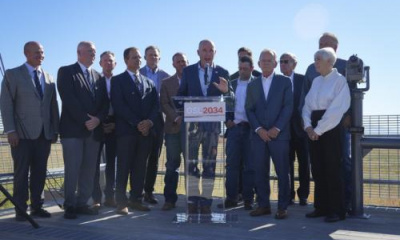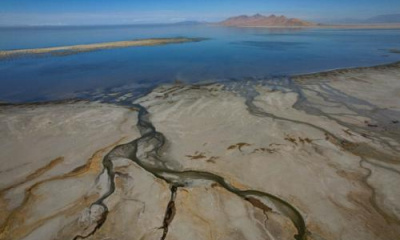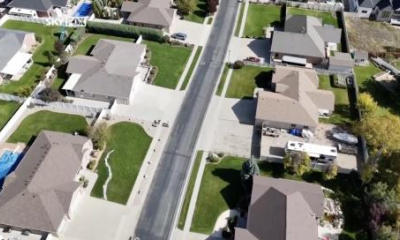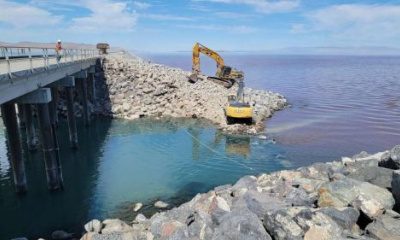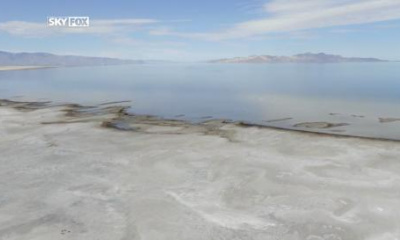For Brian Footen, it will be the biggest and most challenging destination in a project to create Google Street View-style maps of drought-stricken waters and shores across the West.
Spiral Jetty • Brian Footen waded out from the soupy red water of the Great Salt Lake’s north arm, his boat and bibs crusted in brine, his cockpit filled with foam, a wide toothy grin on his face.
It was his first time navigating one of the most inhospitable places on the planet. After eight hours battling a persistent headwind and seeing little life other than a few pelicans, Footen summed up the lake in a word: “Epic.”
“Embrace the salt,” he added with a chuckle.
That quick trip late last month was the reconnaissance mission for a much bigger expedition. Starting in June, Footen plans to launch a project exploring charismatic waters across the West under threat by the current “megadrought.” Mile by mile, he’ll kayak along the rapidly changing shorelines of places like Lake Powell, Lake Mead, Lake Tahoe and New Mexico’s Rio Grande.
The Great Salt Lake, however, is his priority.
“What’s going on with the Great Salt Lake,” he said, “is one of the greatest environmental challenges in the country right now.”
Footen is the founder of a scrappy startup called EarthViews that explores shores and near-shore environments. With a 360-degree GoPro camera mounted to his kayak, he’s able to create interactive, street-view-style maps and share a fresh perspective of waterways with the public.
Based in relatively wet Seattle, Footen began a crowdsource-funded project to follow 1,200 miles along Puget Sound in 2021. His attention shifted farther afield after reading news stories about the decadeslong drought choking nearby states like Utah.
The Great Salt Lake, in particular, grabbed headlines after it sank to a record low last summer. That’s how Footen learned of its plight and the long-term consequences if it continues to shrivel.
“What happens if the whole thing goes dry,” Footen said, “and this turns into a deserted wasteland of toxic air and dust storms?”
He also drew inspiration from a pair of Utahns who circumnavigated the Great Salt Lake last fall to raise awareness about its decline (although those paddlers didn’t always follow the shoreline in an effort to avoid bottoming out since the lake is so shallow). Footen figured he could offer an up-close outlook of his own.
“This is a really compelling way for people to see waterways and become connected with them,” he said. “And if they connect with them, maybe they’ll take the next step and want to protect them.”
He pointed to a trip state lawmakers took in February to view the desiccated lake via helicopter, which, in part, motivated them to pass a slew of water conservation bills last session, including a $40 million trust to specifically help the Great Salt Lake secure more water.
A shoreline-level view, Footen said, offers policymakers and the public an even more granular view of waterways in peril.
“There’s something you get from an intuitive water-level perspective that you don’t get from the air,” he said. “Plus, being on the water allows us to collect a lot of information you can’t get from the air.”
Along with cameras that capture geolocated photos every 10 seconds, Footen plans to collect video footage, data on water quality and record any sightings of shorebirds or wildlife.
“You’ll have a fully immersive experience of the entire nearshore and the lake,” Footen said, “that will hopefully help conservationists and help stakeholders.”
But with its hypersaline environment, extreme isolation in places, and shear size, mapping the Great Salt Lake’s roughly 200 miles of shoreline will prove a formidable task.
“I’m sure we’ll bump into lots and lots of challenges,” Footen said. “And that’s part of the adventure.”
What has happened to the Spiral Jetty?
Footen’s reconnaissance trip to the north arm lasted two days in late March, when he paddled about 20 miles near the Promontory Point peninsula, testing the waters for his lakewide survey come June.
He began and ended each day at the Spiral Jetty, an icon of the land art movement, and one of the few waypoints in one of the lake’s most remote stretches. The famous 1,500-foot coil of basalt boulders became submerged two years after artist Robert Smithson sculpted it in 1970 as an homage to an environment in flux.
The Great Salt Lake began to recede in the early 2000s, fueled by the current megadrought and unfettered diversion of its tributary rivers to water farms, cities and suburban turf.
Today, the jetty sits nearly a mile from the water’s edge. It made for a grueling portage as Footen dragged his equipment-laden kayak across the salt-crusted lakebed, on a particularly hot day for early spring.
He said he researched satellite imagery and aerial photos to have some idea of the trek involved to reach and navigate the water.
But “aerials don’t tell you anything about what it’s like here,” he said, while families picnicked, tossed beach balls and flew kites at the land art nearby. “That’s another reason to have this kind of perspective, this water-level perspective.”
Seeing the lake from above also didn’t prepare him for its otherworldly, sometimes disorienting nature.
“I can’t tell how far away I am from anything” while paddling, Footen said. “I think, ‘I’ll just kayak to that point right there. No big deal.’ Well, three hours later, you’re still not there.”
He gestured west to Gunnison Island, one of the largest breeding grounds for American white pelicans on the continent.
“This little island has been following me the whole way everywhere I go,” Footen laughed.
The Great Salt Lake doesn’t have islands anymore — the water is so low they’ve formed land bridges and disrupted sites nesting birds select for their isolation from people and predators.
“You don’t see that in pictures,” Footen said, adding land bridges to the long list of Great Salt Lake obstacles he’ll have to navigate.
Spring and early summer bring the lake’s infamous biting insects, for example, and the lake is prone to turbulent weather. If Footen runs into problems, the lake’s elevation is so low that rescue crews won’t be able to launch boats to save him. He’ll likely need permission and a permit from the Utah Division of Forestry, Fire and State Lands as well, which manages the lakebed.
(Footen said he has not yet contacted state regulators, which a division representative confirmed. That representative declined to comment on Footen’s plans.)
The lake’s saline water also wreaked havoc on cameras and water chemistry gadgets Footen uses.
“The dissolved oxygen [meter] got ruined yesterday, just … clogged up with salt crystals,” he said. “That’s why I’m out here right now, right? Learning lessons.”
‘I’m going to do Google Street View for rivers’
Footen grew up visiting the renowned Shedd Aquarium in Chicago, which spawned his interest in aquatic environments. After high school, he moved to the University of Washington to study marine biology, but promptly dropped out, journeyed to Alaska and landed a job on a fishing boat.
“That’s why things like this don’t faze me,” he said, taking a break while tugging his rig across the lakebed under the baking sun.
Footen spent nearly four years reeling in ton after ton of cod, he said, which involved 30 days at sea at a time aboard a 180-foot boat with 30 other crew members. He wanted to ensure he had enough grit for a career devoted to water and all its turmoil.
“I was like, ‘Yeah, this marine biology thing is definitely something I want to do,’” Footen said, “and I’ve killed enough fish now that I owe them back.”
He earned a dual master’s degree in fisheries science from Evergreen State College and the University of Washington in 2001. He has spent two decades working on salmon habitat restoration, at times for federal and state agencies, but mostly for tribes in the Pacific Northwest.
Around 2015, Footen began dabbling in entrepreneurship. Wildlife managers sometimes use helicopters to monitor fish populations, but Footen figured he could use drones instead.
“It’s better for the climate,” he said, “[and] we could cut the price by two-thirds, easy.”
He shifted his focus to boat-based photography after studying Washington’s Green River on Google Maps, he said. After some colleagues zoomed in on a bridge using Street View to assess bank erosion, Footen had his “eureka” moment.
“Screw the drones,” Footen recalled thinking. “I’m going to do Street View for rivers.”
‘A game changer’
Some policymakers and conservation groups are seeing value in having a boat-based level, at least in Footen’s home state.
This past session, the Washington Legislature considered a bill, SB5885, that would require an on-the-water-view survey of Puget Sound every two years to better understand environmental impacts that are going undetected and unpermitted.
The legislation didn’t make it to the House floor, but it had enough support in the Senate and received backing from environmental groups like the Audubon Society and Sound Action.
“I can tell you, the kind of work [Footen is] taking on, it’s so important,” said Amy Carey, executive director of Sound Action. “It’s a game changer.”
Footen has mapped 500 miles of Puget Sound so far. He put that project on hold to begin his survey of the West’s drought-stricken waters, especially the Great Salt Lake.
The project is entirely self-funded for now, with Footen sleeping in the back of his truck to help cut costs. He said he has assembled a crew of three volunteers to help him with his full survey of the Great Salt Lake in June, which, after his initial scouting last month, he expects to take between 15 and 20 days.
“I’m delighted that, all the way from another state, he’s coming and making this commitment,” said Lynn de Freitas with FRIENDS of Great Salt Lake, while cautioning Footen and his team to watch out for the lake’s notorious biting gnats. “Expect some no-see-ums.”
Bonnie Baxter, director of Westminster College’s Great Salt Lake Institute, said she’s particularly interested in imagery Footen collects of the lake’s microbialites — bacterial mats that create round rock structures from the lake’s minerals and serve as a crucial part of its food chain. Microbialites tend to hug the shoreline’s shallow water because they need sunlight to thrive. But as the lake shrinks, the organisms are becoming exposed to air and spiking levels of salinity, leading to their collapse.
“If Brian’s work can call attention to the significance of these structures and give us information about the rate of loss, that will really help our science,” she said. “... He has a platform to amplify this crisis at the lake.”




